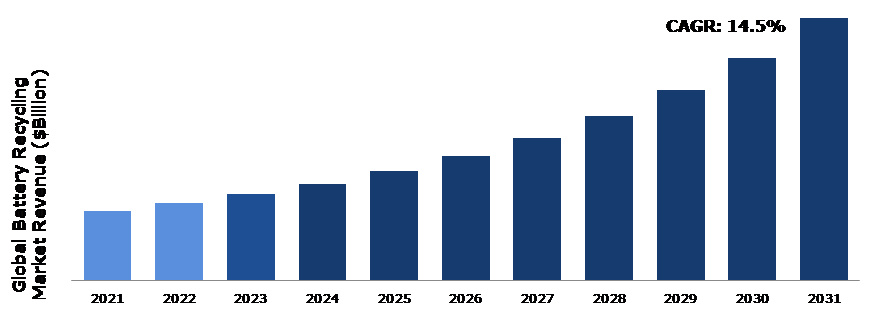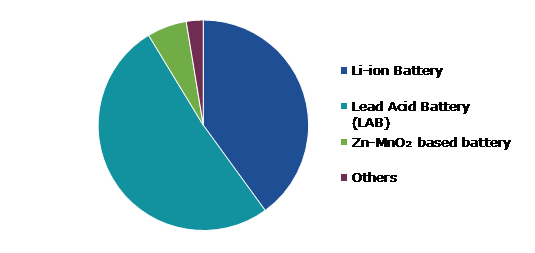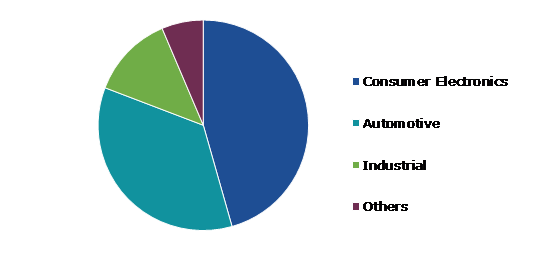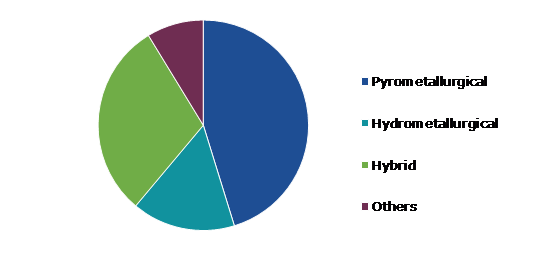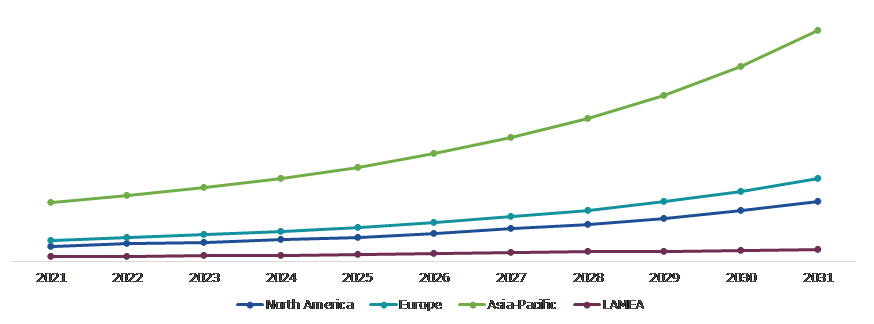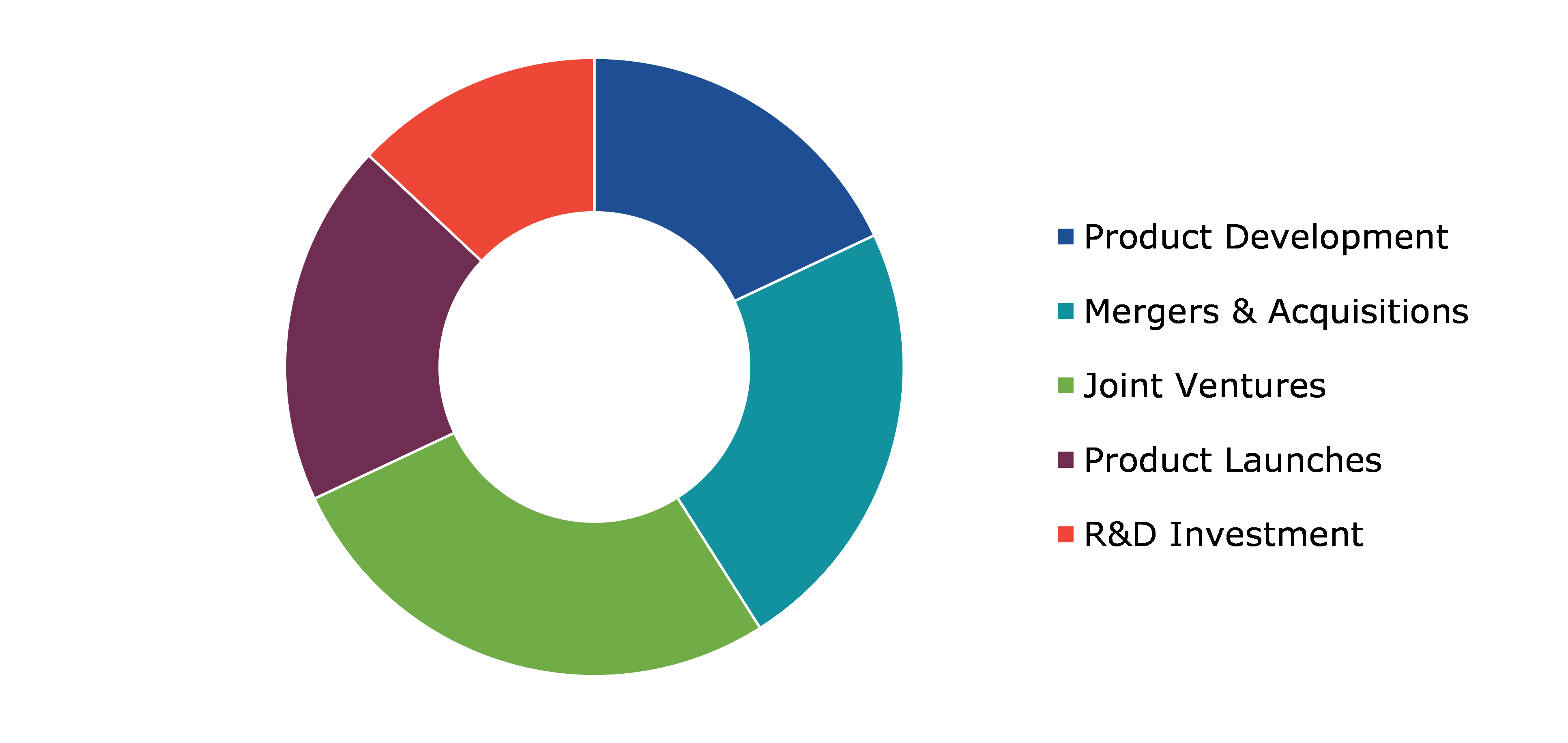Battery Recycling Market Report
RA00011
Battery Recycling Market by Battery Type (Li-ion Battery, Lead Acid Battery (LAB), Nickel-based Battery, Zn-MnO₂ based battery, and Others), Source (Consumer Electronics, Automotive, Industrial, and Others), Technology (Pyrometallurgical, Hydrometallurgical, Hybrid, and Others), and Regional Analysis (North America, Europe, Asia-Pacific, and LAMEA): Global Opportunity Analysis and Industry Forecast, 2022-2031
Global Battery Recycling Market Analysis
The Global Battery Recycling Market Size was $12.5 billion in 2021 and is predicted to grow with a CAGR of 14.5%, by generating a revenue of $47.2 billion by 2031.
Global Battery Recycling Market Synopsis
The increasing demand for electric vehicles (EVs) and the rising adoption of renewable energy sources are the primary drivers of the battery recycling market. As the use of EVs continues to grow, so does the demand for lithium-ion batteries, which are used to power these vehicles. Battery recycling provides a sustainable solution for managing end-of-life batteries by recovering valuable metals such as cobalt, nickel, and lithium from spent batteries. These recovered materials can then be reused in the production of new batteries, reducing the reliance on virgin materials and lowering the environmental impact of battery production. Furthermore, governments and regulatory bodies around the world are implementing stringent environmental regulations to reduce greenhouse gas emissions and promote sustainability. These factors are anticipated to boost the battery recycling industry growth in the upcoming years.
However, one of the disadvantages of battery recycling is that of high costs. The high cost of recycling can make it challenging for new companies to enter the market, which can limit competition and innovation in the industry. As a result, the availability of recycling services may be limited, and the cost of these services may be higher than necessary. Furthermore, the cost of acquiring and maintaining the necessary equipment and technology for recycling batteries is also high. For example, some battery recycling processes require specialized equipment and materials such as chemicals and high-tech sorting machines.
The rising need for reducing improper disposal of batteries as well as shortage of critical materials such as lithium, cobalt, and nickel are encouraging government investment in battery recycling as well as private investment in a circular economy. This, in turn, may offer lucrative opportunities to battery recyclers. Recovery and reuse of spent batteries present numerous benefits. Secondary use of batteries could lessen the dumping of reusable products, while recycling critical materials such as lithium, nickel, cobalt, copper, etc. from landfills. Many governments are implementing regulations to encourage battery recycling and reduce the environmental impact of electronic waste. This has led to an increase in demand for recycling services and hence provides an opportunity for the battery recycling market to grow.
According to regional analysis, the Asia-Pacific battery recycling market accounted for the highest market share in 2021. China outperforms every other country in the world when it comes to recycling batteries. It had more than three times as much current and projected capacity for recycling lithium-ion batteries as the United States as of the end of 2021. Moreover, growing EV sales across this region, especially in India, Japan, and South Korea are expected to offer ample growth opportunities.
Battery Recycling Overview
Battery recycling is the process of recovering useful materials from used batteries so that they can be reused. The process of battery recycling is important because batteries contain valuable metals such as cobalt, nickel, and lithium, which can be used to make new batteries or other products. Battery recycling has several benefits including reduction of the environmental impact by reducing the amount of waste that ends up in landfills. It also conserves natural resources by reusing valuable metals and materials.
COVID-19 Impact on Global Battery Recycling Market
The COVID-19 pandemic had brought several uncertainties leading to severe economic losses, as various businesses across the world were on a standstill. It had moderate impact on the battery recycling market. In the initial months of the pandemic, the demand for battery recycling reduced due to disruptions in supply chain, closure of manufacturing plants, as well as economic slowdown across several countries. In addition, the import-export restrictions were laid down on major battery recycling countries. Restrictions on travel and transportation had further made it difficult to transport materials and products, which led to delays and increased costs. The pandemic had also led to a reduction in demand for certain types of batteries, such as those used in electric vehicles. This has resulted in a decrease in the number of batteries being recycled, which further impacted the market. The pandemic had also led to a shift in the consumer behavior, with more people working from home and reducing their travel. This impacted the demand for batteries used in portable devices such as laptops and smartphones, which in turn boosted the battery recycling market. Many governments around the world have provided support to the battery recycling market as part of their economic recovery plans. This includes funding for research and development, as well as incentives for companies to invest in battery recycling. For instance, in 2022, The US government announced $3.1 billion funding for battery manufacturing, processing, and recycling.
Growing Demand for Electric Vehicles to Drive the Market Growth
The increasing demand for electric vehicles is one of the main drivers of the battery recycling market. As the adoption of electric vehicles continues to grow, the demand for batteries also increases, which in turn increases the need for battery recycling services. The batteries used in electric vehicles contain valuable metals such as lithium, cobalt, and nickel, which can be recovered through recycling. These metals are in high demand for use in new batteries, as well as other applications, such as consumer electronics and renewable energy storage. Battery recycling not only helps to recover valuable materials, but also reduces the environmental impact of battery production and disposal. By recycling batteries, the amount of waste sent to landfills is reduced, and the environmental impact of mining for new materials is also minimized. The increasing demand for electric vehicles is a significant driver of the battery recycling market, and as the adoption of electric vehicles continues to grow, the demand for battery recycling services is expected to increase.
To know more about global battery recycling market drivers, get in touch with our analysts here.
High Initial Costs for Battery Recycling to Restrain the Market Growth
Battery recycling plants require significant capital investments to build and operate, which can be a deterrent for companies looking to enter the market. The high cost of entry can limit the number of companies able to operate in the market, which in turn can limit the availability of recycling services. The high initial costs of building and operating battery recycling plants can be a significant restraint to the growth of the battery recycling market. The cost of entry into the market can be prohibitively high, especially for small and medium-sized enterprises that may not have financial resources to invest in large-scale recycling facilities. These factors restrain the market growth.
Growing Demand for Lithium-ion Batteries to Drive Excellent Opportunities
The growing demand for lithium-ion batteries in various electronic devices and electric vehicles, smartphones, and other electronics produced is projected to generate opportunities in the battery recycling market. The rise in environmental concerns about e-waste and hazardous chemicals in batteries has led to an increase in demand for battery recycling services. The recycling of these batteries has become increasingly important due to the environmental impact of extracting these metals from the earth. Recycling batteries reduces the need for mining, which causes significant damage to the environment, and also reduces the amount of waste that ends up in landfills. Furthermore, lithium-ion batteries contain valuable metals like cobalt, nickel, and lithium that can be recovered through recycling. As the demand for these metals increases, recycling becomes more cost-effective and attractive. All these factors are significant opportunities for the battery recycling industry growth in the upcoming years.
To know more about global battery recycling market opportunities, get in touch with our analysts here.
Global Battery Recycling Market, by Battery Type
Based on battery type, the market has been divided into li-ion battery, lead acid battery (LAB), nickel-based battery, Zn-MnO₂ based battery, and others. Among these, the lead acid battery sub-segment accounted for the highest market share in 2021 whereas the Li-ion battery sub-segment is estimated to show the fastest growth during the forecast period.
Global Battery Recycling Market Size, by Battery Type, 2021
Source: Research Dive Analysis
The lead acid battery (LAB) sub-type accounted for the largest market share in 2021. Currently, LAB recycling is more advanced with a recycling rate of more than 90%, whereas it is below 5% for Li-ion batteries. Pyrometallurgical recycling technology dominates industrial LAB recycling. In the U.S. alone LABs have a recycling rate of more than 99%, making them the most recycled consumer product. The high recycling rate is majorly attributed to the industry's investment in a closed-loop collection and recycling system that avoids batteries from ending up in landfills.
The li-ion battery sub-type is anticipated to show the fastest growth during the forecast period. The utilization of Li-ion batteries in consumer electronics, energy storage systems, and electric vehicles is expanding at a rapid pace, which is propelling the demand for critical materials such as lithium and cobalt. Therefore, the focus on recycling batteries is increasing by governments, EV manufacturers, as well as recyclers for developing sustainable products as well as facilitating the shortage of critical minerals and lowering pollution from unsafe components.
Global Battery Recycling Market, by Source
Based on source, the market has been divided into consumer electronics, automotive, industrial, and others. Among these, the consumer electronics sub-segment accounted for the largest market share in 2021.
Global Battery Recycling Market Share, by Source, 2021
Source: Research Dive Analysis
The consumer electronics sub-segment held the largest market share of the battery recycling market in 2021. In the last few years, the demand for batteries has increased along with the increasing demand for electronic devices, which has increased battery waste. Battery recycling not only reduces electronic waste in landfills but also serves as a source of raw materials to produce new batteries. In the upcoming years, it is anticipated that the market for battery recycling in consumer electronics would expand further. The growing awareness of the effects of electronic waste on the environment is one of the major forces behind this rise. Globally, governments are enacting laws and policies to encourage battery recycling and lessen electronic waste.
Global Battery Recycling Market, by Technology
Based on technology, the market has been divided into pyrometallurgical, hydrometallurgical, hybrid, and others. Among these, the pyrometallurgical sub-segment held largest market share in 2021.
Global Battery Recycling Market Growth, by Technology, 2021
Source: Research Dive Analysis
The pyrometallurgical sub-segment accounted for the highest market share in 2021. The market for batteries is growing significantly owing to the demand for electric vehicles and consumer electronic products; however, the massive amount of used batteries that will be produced as a result will cause serious environmental issues. Pyrometallurgical technique is an appropriate technique for recycling these batteries in large-scale industrial applications due to its various benefits such as less waste liquid output and high efficiency. A high percentage of metals from used batteries can be recovered using the pyrometallurgical recycling technique, making it the most efficient technique for battery recycling.
Global Battery Recycling Market, Regional Insights
The battery recycling market was investigated across North America, Europe, Asia-Pacific, and LAMEA.
Global Battery Recycling Market Size & Forecast, by Region, 2021-2031 (USD Billion)
Source: Research Dive Analysis
The Market for Battery Recycling in Asia-Pacific Accounted for the Largest Market Share in 2021
The Asia-Pacific battery recycling market accounted for the largest market share in battery recycling industry in 2021, owing to some of the major factors such as presence of major players in China and rising EV and electronic product sales across India, Japan, South Korea, and Australia. China leads the battery recycling market in this region. China's policies require a high-voltage battery tracking system to assure that batteries can be recycled after their usage in various applications. Since the extraction of cobalt, lithium, and other critical materials could harm the environment, the government of China has decided to avoid the unregulated dumping of Li-ion batteries.
Competitive Scenario in the Global Battery Recycling Market
Investment and agreement are common strategies followed by major market players. For instance, in 2022, Attero, one of the major players in the battery recycling business in India, announced around $80 million investment to set up Li-ion battery recycling plant in southern part of India.
Source: Research Dive Analysis
Some of the leading battery recycling market players are GEM Co., Ltd., Guangdong Brunp recycling Technology Co., Ltd., Battery Systems Inc., Umicore, ENERSYS, Glencore, Li-Cycle Corporation, The Doe Run Company, ACCUREC-Recycling GmbH, RecycLiCo Battery Materials Inc., and others.
| Aspect | Particulars |
| Historical Market Estimations | 2020 |
| Base Year for Market Estimation | 2021 |
| Forecast Timeline for Market Projection | 2022-2031 |
| Geographical Scope | North America, Europe, Asia-Pacific, LAMEA |
| Segmentation by Battery Type |
|
| Segmentation by Source |
|
| Segmentation by Technology |
|
| Key Companies Profiled |
|
Q1. What is the size of the global battery recycling market?
A. The size of the global battery recycling market was over $12.5 billion in 2021 and is projected to reach $47.2 million by 2031
Q2. Which are the major companies in the battery recycling market?
A. Glencore, Umicore, and GEM Co., Ltd. are some of the key players in the global battery recycling market.
Q3. Which region, among others, possesses greater investment opportunities in the near future?
A. The Asia-Pacific region possesses great investment opportunities for investors to witness the most promising growth in the future.
Q4. What will be the growth rate of the Asia-Pacific battery recycling market?
A. Asia-Pacific battery recycling market is anticipated to grow at 14.9% CAGR during the forecast period.
Q5. What are the strategies opted by the leading players in this market?
A. Agreement and investment are the two key strategies opted by the operating companies in this market.
Q6. Which companies are investing more on R&D practices?
A. Guangdong Brunp recycling Technology Co., Ltd., Li-Cycle Corporation, and RecycLiCo Battery Materials Inc. are the companies investing more on R&D activities for developing new products and technologies.
1.Research Methodology
1.1.Desk Research
1.2.Real time insights and validation
1.3.Forecast model
1.4.Assumptions and forecast parameters
1.5.Market size estimation
1.5.1.Top-down approach
1.5.2.Bottom-up approach
2.Report Scope
2.1.Market definition
2.2.Key objectives of the study
2.3.Report overview
2.4.Market segmentation
2.5.Overview of the impact of COVID-19 on Global battery recycling market
3.Executive Summary
4.Market Overview
4.1.Introduction
4.2.Growth impact forces
4.2.1.Drivers
4.2.2.Restraints
4.2.3.Opportunities
4.3.Market value chain analysis
4.3.1.List of raw material suppliers
4.3.2.List of manufacturers
4.3.3.List of distributors
4.4.Innovation & sustainability matrices
4.4.1.Technology matrix
4.4.2.Regulatory matrix
4.5.Porter’s five forces analysis
4.5.1.Bargaining power of suppliers
4.5.2.Bargaining power of consumers
4.5.3.Threat of substitutes
4.5.4.Threat of new entrants
4.5.5.Competitive rivalry intensity
4.6.PESTLE analysis
4.6.1.Political
4.6.2.Economical
4.6.3.Social
4.6.4.Technological
4.6.5.Environmental
4.7.Impact of COVID-19 on battery recycling market
4.7.1.Pre-covid market scenario
4.7.2.Post-covid market scenario
5.Battery Recycling Market Analysis, by Battery Type
5.1.Overview
5.2.Li-ion Battery
5.2.1.Definition, key trends, growth factors, and opportunities
5.2.2.Market size analysis, by region
5.2.3.Market share analysis, by country
5.3.Lead Acid Battery (LAB)
5.3.1.Definition, key trends, growth factors, and opportunities
5.3.2.Market size analysis, by region
5.3.3.Market share analysis, by country
5.4.Nickel-based Battery
5.4.1.Definition, key trends, growth factors, and opportunities
5.4.2.Market size analysis, by region
5.4.3.Market share analysis, by country
5.5.Zn-MnO₂ based battery
5.5.1.Definition, key trends, growth factors, and opportunities
5.5.2.Market size analysis, by region
5.5.3.Market share analysis, by country
5.6.Others
5.6.1.Definition, key trends, growth factors, and opportunities
5.6.2.Market size analysis, by region
5.6.3.Market share analysis, by country
5.7.Research Dive Exclusive Insights
5.7.1.Market attractiveness
5.7.2.Competition heatmap
6.Battery Recycling Market Analysis, by Source
6.1.Consumer Electronics
6.1.1.Definition, key trends, growth factors, and opportunities
6.1.2.Market size analysis, by region
6.1.3.Market share analysis, by country
6.2.Automotive
6.2.1.Definition, key trends, growth factors, and opportunities
6.2.2.Market size analysis, by region
6.2.3.Market share analysis, by country
6.3.Industrial
6.3.1.Definition, key trends, growth factors, and opportunities
6.3.2.Market size analysis, by region
6.3.3.Market share analysis, by country
6.4.Others
6.4.1.Definition, key trends, growth factors, and opportunities
6.4.2.Market size analysis, by region
6.4.3.Market share analysis, by country
6.5.Research Dive Exclusive Insights
6.5.1.Market attractiveness
6.5.2.Competition heatmap
7.Battery Recycling Market Analysis, by Technology
7.1.Pyrometallurgical
7.1.1.Definition, key trends, growth factors, and opportunities
7.1.2.Market size analysis, by region
7.1.3.Market share analysis, by country
7.2.Hydrometallurgical
7.2.1.Definition, key trends, growth factors, and opportunities
7.2.2.Market size analysis, by region
7.2.3.Market share analysis, by country
7.3.Hybrid
7.3.1.Definition, key trends, growth factors, and opportunities
7.3.2.Market size analysis, by region
7.3.3.Market share analysis, by country
7.4.Others
7.4.1.Definition, key trends, growth factors, and opportunities
7.4.2.Market size analysis, by region
7.4.3.Market share analysis, by country
7.5.Research Dive Exclusive Insights
7.5.1.Market attractiveness
7.5.2.Competition heatmap
8.Battery Recycling Market, by Region
8.1.North America
8.1.1.U.S.
8.1.1.1.Market size analysis, by Battery Type
8.1.1.2.Market size analysis, by Source
8.1.1.3.Market size analysis, by Technology
8.1.2.Canada
8.1.2.1.Market size analysis, by Battery Type
8.1.2.2.Market size analysis, by Source
8.1.2.3.Market size analysis, by Technology
8.1.3.Mexico
8.1.3.1.Market size analysis, by Battery Type
8.1.3.2.Market size analysis, by Source
8.1.3.3.Market size analysis, by Technology
8.1.4.Research Dive Exclusive Insights
8.1.4.1.Market attractiveness
8.1.4.2.Competition heatmap
8.2.Europe
8.2.1.Germany
8.2.1.1.Market size analysis, by Battery Type
8.2.1.2.Market size analysis, by Source
8.2.1.3.Market size analysis, by Technology
8.2.2.UK
8.2.2.1.Market size analysis, by Battery Type
8.2.2.2.Market size analysis, by Source
8.2.2.3.Market size analysis, by Technology
8.2.3.France
8.2.3.1.Market size analysis, by Battery Type
8.2.3.2.Market size analysis, by Source
8.2.3.3.Market size analysis, by Technology
8.2.4.Spain
8.2.4.1.Market size analysis, by Battery Type
8.2.4.2.Market size analysis, by Source
8.2.4.3.Market size analysis, by Technology
8.2.5.Italy
8.2.5.1.Market size analysis, by Battery Type
8.2.5.2.Market size analysis, by Source
8.2.5.3.Market size analysis, by Technology
8.2.6.Rest of Europe
8.2.6.1.Market size analysis, by Battery Type
8.2.6.2.Market size analysis, by Source
8.2.6.3.Market size analysis, by Technology
8.2.7.Research Dive Exclusive Insights
8.2.7.1.Market attractiveness
8.2.7.2.Competition heatmap
8.3.Asia Pacific
8.3.1.China
8.3.1.1.Market size analysis, by Battery Type
8.3.1.2.Market size analysis, by Source
8.3.1.3.Market size analysis, by Technology
8.3.2.Japan
8.3.2.1.Market size analysis, by Battery Type
8.3.2.2.Market size analysis, by Source
8.3.2.3.Market size analysis, by Technology
8.3.3.India
8.3.3.1.Market size analysis, by Battery Type
8.3.3.2.Market size analysis, by Source
8.3.3.3.Market size analysis, by Technology
8.3.4.Australia
8.3.4.1.Market size analysis, by Battery Type
8.3.4.2.Market size analysis, by Source
8.3.4.3.Market size analysis, by Technology
8.3.5.South Korea
8.3.5.1.Market size analysis, by Battery Type
8.3.5.2.Market size analysis, by Source
8.3.5.3.Market size analysis, by Technology
8.3.6.Rest of Asia Pacific
8.3.6.1.Market size analysis, by Battery Type
8.3.6.2.Market size analysis, by Source
8.3.6.3.Market size analysis, by Technology
8.3.7.Research Dive Exclusive Insights
8.3.7.1.Market attractiveness
8.3.7.2.Competition heatmap
8.4.LAMEA
8.4.1.Brazil
8.4.1.1.Market size analysis, by Battery Type
8.4.1.2.Market size analysis, by Source
8.4.1.3.Market size analysis, by Technology
8.4.2.Saudi Arabia
8.4.2.1.Market size analysis, by Battery Type
8.4.2.2.Market size analysis, by Source
8.4.2.3.Market size analysis, by Technology
8.4.3.UAE
8.4.3.1.Market size analysis, by Battery Type
8.4.3.2.Market size analysis, by Source
8.4.3.3.Market size analysis, by Technology
8.4.4.South Africa
8.4.4.1.Market size analysis, by Battery Type
8.4.4.2.Market size analysis, by Source
8.4.4.3.Market size analysis, by Technology
8.4.5.Rest of LAMEA
8.4.5.1.Market size analysis, by Battery Type
8.4.5.2.Market size analysis, by Source
8.4.5.3.Market size analysis, by Technology
8.4.6.Research Dive Exclusive Insights
8.4.6.1.Market attractiveness
8.4.6.2.Competition heatmap
9.Competitive Landscape
9.1.Top winning strategies, 2021
9.1.1.By strategy
9.1.2.By year
9.2.Strategic overview
9.3.Market share analysis, 2021
10.Company Profiles
10.1.GEM Co., Ltd.
10.1.1.Overview
10.1.2.Business segments
10.1.3.Product portfolio
10.1.4.Financial performance
10.1.5.Recent developments
10.1.6.SWOT analysis
10.2.Guangdong Brunp recycling Technology Co., Ltd.
10.2.1.Overview
10.2.2.Business segments
10.2.3.Product portfolio
10.2.4.Financial performance
10.2.5.Recent developments
10.2.6.SWOT analysis
10.3.Battery Systems Inc.
10.3.1.Overview
10.3.2.Business segments
10.3.3.Product portfolio
10.3.4.Financial performance
10.3.5.Recent developments
10.3.6.SWOT analysis
10.4.UMICORE
10.4.1.Overview
10.4.2.Business segments
10.4.3.Product portfolio
10.4.4.Financial performance
10.4.5.Recent developments
10.4.6.SWOT analysis
10.5.ENERSYS
10.5.1.Overview
10.5.2.Business segments
10.5.3.Product portfolio
10.5.4.Financial performance
10.5.5.Recent developments
10.5.6.SWOT analysis
10.6.Glencore
10.6.1.Overview
10.6.2.Business segments
10.6.3.Product portfolio
10.6.4.Financial performance
10.6.5.Recent developments
10.6.6.SWOT analysis
10.7.Li-Cycle Corporation
10.7.1.Overview
10.7.2.Business segments
10.7.3.Product portfolio
10.7.4.Financial performance
10.7.5.Recent developments
10.7.6.SWOT analysis
10.8.The Doe Run Company
10.8.1.Overview
10.8.2.Business segments
10.8.3.Product portfolio
10.8.4.Financial performance
10.8.5.Recent developments
10.8.6.SWOT analysis
10.9.ACCUREC-Recycling GmbH
10.9.1.Overview
10.9.2.Business segments
10.9.3.Product portfolio
10.9.4.Financial performance
10.9.5.Recent developments
10.9.6.SWOT analysis
10.10.RecycLiCo Battery Materials Inc.
10.10.1.Overview
10.10.2.Business segments
10.10.3.Product portfolio
10.10.4.Financial performance
10.10.5.Recent developments
10.10.6.SWOT analysis
In today’s technologically advanced world, batteries play a crucial role in powering a wide range of devices, from smartphones and laptops to electric vehicles and renewable energy systems. However, the increasing demand for batteries has also led to a rise in battery waste, posing significant environmental health risks. This is where battery recycling comes into play. Batteries contain various toxic and hazardous materials, including heavy metals like lead, mercury, and cadmium as well as lithium and other potentially harmful chemicals. If not disposed of properly, these substances can leach into soil and water, contaminating ecosystems and posing serious risks to human and animal health. By recycling batteries, these valuable materials can be recovered, and the environment can be protected. Battery recycling reduces the demand for virgin resources, and recycling contributes to a more sustainable and circular economy. Moreover, the recycling process for batteries requires less energy compared to the production of new batteries from raw materials.
Forecast Analysis of the Global Battery Recycling Market
According to the report published by Research Dive, the global battery recycling market is anticipated to $47.2 billion and grow at a stunning CAGR of 14.5% over the forecast period from 2022 to 2031.
The increasing demand for electric vehicles among individuals globally has increased the demand for batteries, which is expected to bolster the growth of the global battery recycling market over the estimated timeframe. Moreover, the growing demand for lithium-ion batteries in various electronic devices such as smartphones, laptops, and many other electronics and electric vehicles is predicted to create massive growth opportunities for the market throughout the forecast period. However, high initial costs for battery recycling may hinder the growth of the market during the analysis timeframe.
The major players of the battery recycling market include RecycLiCo Battery Materials Inc., GEM Co., Ltd., ACCUREC-Recycling GmbH, Guangdong Brunp Recycling Technology Co., Ltd., The Doe Run Company, Battery Systems Inc., Li-Cycle Corporation, Umicore, Glencore, EnerSys, and many more.
Key Developments of the Battery Recycling Market
The key companies operating in the industry are adopting various growth strategies & business tactics such as partnerships, collaborations, mergers & acquisitions, and launches to maintain a robust position in the overall market, which is subsequently helping the global battery recycling market to grow exponentially. For instance:
- In March 2023, Stena Recycling, a leading Swedish-based company that focuses on sustainable waste management and recycling services to businesses and communities launched its first recycling facility for lithium-ion batteries. This unit is equipped with advanced recycling techniques that could recycle 95% of an electric battery recycling.
- In April 2023, Volkswagen of America, Inc., one of the world’s leading automobile manufacturers announced its collaboration with an American company that focuses on recycling lithium-ion batteries to produce battery materials for electromobility and electrical storage systems. With this collaboration, the companies aimed to make a battery recycling strategy for all Volkswagen and Audi electric vehicle battery packs and promote a circular EV economy.
- In May 2023, Blue Whale Materials, a leading battery recycling company announced its acquisition of Eclipse Energy, a renowned battery testing and evaluation lab. This acquisition would enable Blue Whale Materials to expand its battery testing and evaluation process of the life cycle of batteries.
Most Profitable Region
The Asia-Pacific region of the battery recycling market generated the highest revenue during the estimated timeframe. The strong existence of strong market players across the region and the growing demand for high-voltage battery tracking systems among them are expected to boost the regional growth of the market throughout the analysis period.
Covid-19 Impact on the Battery Recycling Market
Though the outbreak of the Covid-19 pandemic has brought several uncertainties across various industries., it has had a moderate impact on the battery recycling market. Initially, the disruptions in the supply chain, closure of manufacturing plants, and severe economic slowdown have reduced the demand for battery recycling. Moreover, the decreased demand for batteries used in electric vehicles has further reduced the rate of the battery recycling process during the pandemic. However, the rising adoption of work-from-home culture among organizations has increased the demand for batteries used in portable devices. This has increased the demand for battery recycling throughout the crisis.
Personalize this research
- Triangulate with your own data
- Request your format and definition
- Get a deeper dive on a specific application, geography, customer or competitor
- + 1-888-961-4454 Toll - Free
- support@researchdive.com

